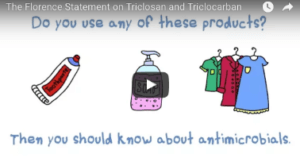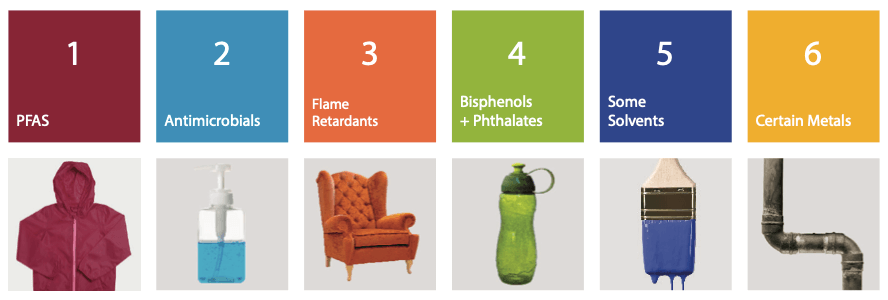June 2017: Buyer Beware: Are you using antimicrobials?
In this edition:
- Buyer Beware: Antimicrobial Products Can Do More Harm Than Good
- Are there toxic chemicals coating your pet food bag?
- Toxic switch: From one harmful flame retardant to another
- Highly Fluorinated Compounds: Social and Scientific Discovery
- The Six Classes Approach to Reducing Harmful Chemicals

We hope you are enjoying the beginning of summer. Last week marked the culmination of nearly two years of research and planning with the launch of both the Florence statement on Triclosan and Triclocarban and our series of four- minute long videos on Six Classes of chemicals of concern. These videos will bring to a much larger audience our Six Classes strategy of limiting the use of harmful chemical classes for healthier products and people. You can view the videos on our new website at www.SixClasses.org or click the image on the right to see the Introductory video which will lead you to the other six videos.
We hope you can join us this Thursday, June 29, at 11am Pacific for a webcast featuring short videos and live discussion about flame retardants and bisphenols & phthalates with Mark Leno, candidate for Mayor of San Francisco and Ken Cook, President of the Environmental Working Group. There is more information below and you can register here for the June 29 and July 6 webcasts.
The Florence statement is also discussed more below. We hope it will follow our San Antonio Statement on Flame Retardants and Madrid statement on Highly Fluorinated Chemicals, in having an impact in reducing the unnecessary use of classes of chemicals of concern.
Tom Bruton and I have just finished coordinating a Scientists letter which will be submitted to a peer-reviewed journal: Proposal for coordinated health research in PFAS-contaminated communities. Legislators have already told us the letter is of use in helping communities whose water has been contaminated with highly fluorinated chemicals. Please email Tom or me for a copy of the letter if you are a scientist and would like to read it and consider signing on.
Also, we are always looking to hire outstanding scientists with a passion for reducing the use of toxic chemicals to protect our health and environment. Please visit our jobs page if that sounds interesting to you.
Kind regards,
Arlene and the Green Science Policy team
Buyer Beware: Antimicrobial Products Can Do More Harm Than Good

Are you buying antimicrobial or antibacterial soaps? According to over 200 scientists from 29 countries, you may want to save your money. A consensus statement that we coordinated was published last week in the journal Environmental Health Perspectives concluding that common antimicrobial products do not provide health benefits and cause health and environmental harm.
Last fall, the U.S. Food and Drug Administration (FDA) ruled that 19 different antimicrobial chemicals, including infamous triclosan and triclocarban, were not effective and should not be used in consumer soaps. The Florence Statement states that the FDA’s decision does not go far enough to protect consumers and the environment. The statement received broad media coverage, including articles in The Washington Post, Forbes, and Environmental Health News.
While use of triclosan and triclocarban in soaps has recently declined, soap now often contains substitute antimicrobials which may be no better. Our Six Classes approach advises that the best way to prevent potential harm is to avoid antimicrobial products whenever possible. For tips on how to avoid antimicrobials in products, visit www.GreenSciencePolicy.org/antimicrobials.
Check out our short animated video about antimicrobials above. We think this video is an effective way to communicate the Florence statement in a non-technical way. Do you agree?
Are there toxic chemicals coating your pet food bag?

A few months ago, our Institute and colleagues reported finding fluorinated chemicals in about a third of take-out food packaging samples tested. Previous research has shown these chemicals can migrate from packaging into the food that people eat.
Now, we are launching a similar study to learn if our pets are being exposed to fluorinated chemicals from the packaging around their food. If you have a pet whose food or treats comes in bags, please join our study by sending us a sample of the packaging and we will can test it for fluorinated chemicals. Thank you in advance for participating. You will contribute to our study and learn if your pets might be exposed to fluorinated chemicals.
Directions:
Cut out a 2×2 inch sample of the food or treat bag and place it in a ziplock bag. Record the product information (item name, brand, store name and location) and your contact information (name, email, and mailing address) on a piece of paper. Put the paper in the ziplock bag and mail to:
Green Science Policy Institute, P.O. Box 9127, Berkeley, CA 94709
Toxic switch: From one harmful flame retardant to another

PBDEs flame retardants were phased out in 2005 due to their known health harm; but now many others have replaced them in electronics, building insulation, transportation, etc. According to a recent article, the use of organophosphate flame retardants “….has skyrocketed over the past 15 years, leading to human exposure levels that are even higher than they were for PBDEs at their peak”. These flame retardants lack adequate health information and are being found in increasing amounts in dust, air, and water around the world. One study of wastewater in New York found 16 different types of organophosphate flame retardants.
An important new study from Heather Stapleton’s lab at Duke University found high levels of the flame retardant chlorinated tris, (TDCIPP), which is a probable carcinogen, in infants. The authors compared infants’ daily exposure to this flame retardant to the Consumer Product Safety Commission (CPSC) Acceptable Daily Dose and found that somewhere between 2-9% of infants had exposures higher than the Acceptable Daily Dose. Some of the infants levels were nearly three times the US CPSC acceptable level. These infants’ high exposure to TDCPP is likely a result of the flame retardants use in car seats, mattresses, and other products. One could question the overall benefit of flame retardants in baby products when it leads to many infants being exposed on a daily basis to these harmful chemicals.
Learn more on our website about what you can do to reduce exposures to flame retardants and more about these chemicals from our new short video.
Highly Fluorinated Compounds: Social and Scientific Discovery

Earlier this month, Northeastern University hosted an inspiring conference where members of communities with water contaminated by highly fluorinated chemicals shared their moving stories. One memorable image showed children at a picnic being sprayed by foam containing PFAS. Video recordings of many of the presentations will be posted online soon.
Coincidentally the next day, the U.S. poet laureate Tracy K. Smith, released Watershed, a moving poem about DuPont’s contamination of the Ohio River Valley with PFOA. This poem begins:
Watershed
Tracy K. Smith
200 cows more than 600 hilly acres
property would have been even larger
had J not sold 66 acres to DuPont for
waste from its Washington Works factory
where J was employed
did not want to sell
but needed money poor health
mysterious ailments
Not long after the sale cattle began to act
deranged
The Six Classes Approach to Reducing Harmful Chemicals
You are invited to register for parts 2 and 3 of the online premiere of our new four-minute videos about Six Classes of chemicals of concern in everyday products and how we can all be healthier by reducing their use. The launch webcasts each feature three videos, along with live conversation with distinguished scientists and thought leaders, and questions from the audience.
All seven short videos can be viewed at www.SixClasses.org.
Thursdays June 29 and July 6:
11am-12pm Pacific; 2-3pm Eastern; 8-9pm Central European
Register here (or call 510-898-1704)
June 29: Introduction, Flame Retardants, Bisphenols & Phthalates
Ken Cook, President and Co-Founder, Environmental Working Group
Mark Leno, Retired State Senator and Candidate for Mayor of San Francisco
July 6: Introduction, Some Solvents, Certain Metals
Michael Kirschner, President, Design Chain Associates
Meredith Williams, Deputy Director, Safer Products, California DTSC

Register here. Together we can reduce the use of harmful chemicals and improve health and environment worldwide.
Receive Updates By Email
Subscribe to our monthly newsletter and get these updates delivered right to your inbox!